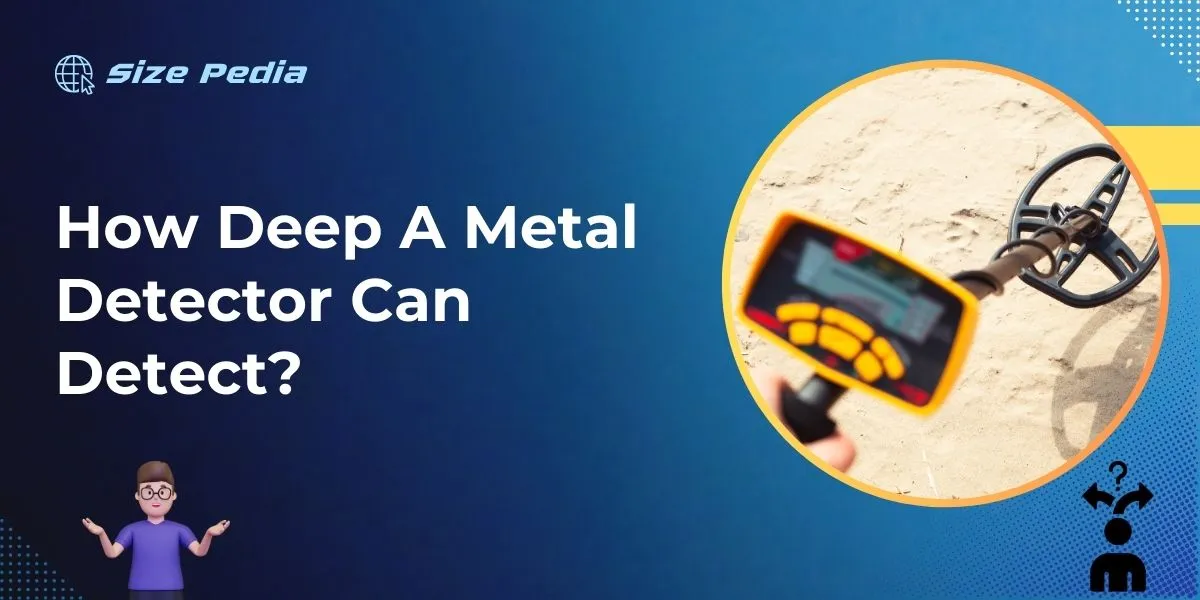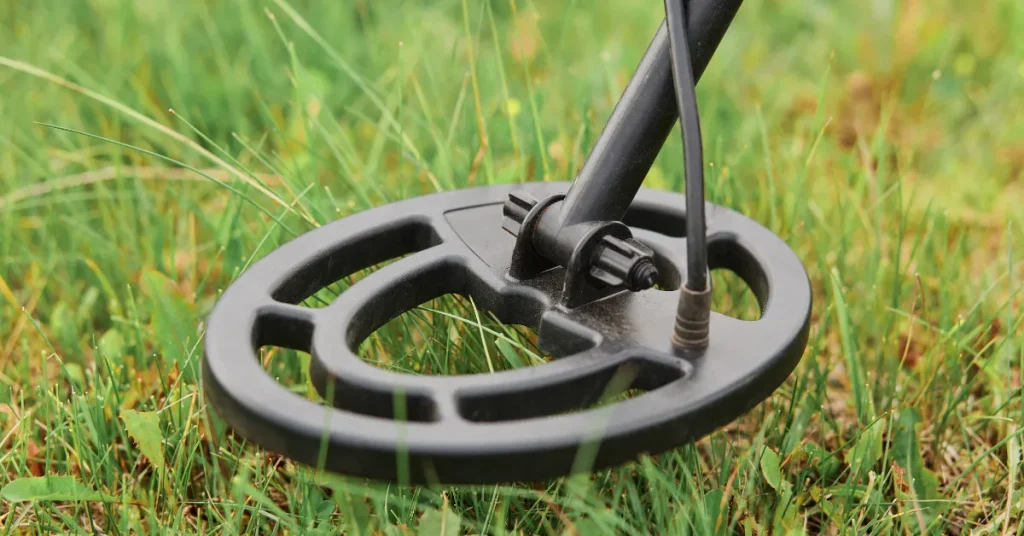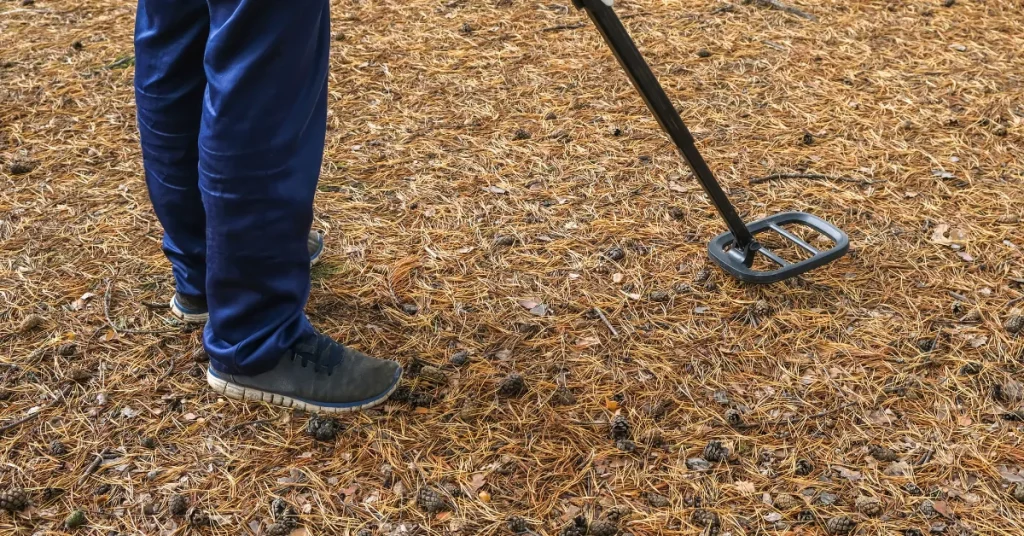A metal detector can detect objects up to several feet deep, depending on the model and conditions. The detection depth varies with object size, material, and soil type.
Metal detecting, a popular hobby and essential in security and construction, depends heavily on the equipment’s sophistication and user expertise.
Depth detection is influenced by factors such as the device’s search coil size, the metal’s conductivity, and ground mineralization.
Advanced detectors with higher frequency and ground balancing features perform better in challenging environments, making them ideal for treasure hunters, archaeologists, and safety personnel.
Novice enthusiasts, meanwhile, can enjoy the thrill of discovery with entry-level models suitable for more casual exploration. Ensuring your metal detector has the right capabilities for your needs greatly enhances the chance of a rewarding search.

Peeking Beneath The Surface
Curious minds and treasure hunters alike often wonder just how deep their metal detectors can pierce the ground. Under the surface lies a realm of hidden treasures, from lost coins to ancient relics, just waiting to be discovered.
Let’s dive into the world beneath our feet and explore the potential and limitations of metal detection technology.
The Fundamentals Of Metal Detection
Understanding metal detection starts with the basics. A metal detector emits an electromagnetic field into the ground.
When this field hits a metal object, the object becomes energized and creates its own electromagnetic field. The detector picks up this response, alerting the user to a potential find.
| Component | Function |
| Search Coil | The part that sends and receives the signals |
| Control Box | Contains the circuitry, controls, speaker, batteries and the microprocessor |
| Stabilizer | Keeps the unit steady as it moves |
| Shaft | Connects the coil to the control box and is usually adjustable |
Factors Influencing Detection Depth
- Type of Metal: Different metals conduct electricity differently, affecting detection.
- Size of Object: Generally, the larger the object, the easier it is to detect.
- Search Coil Size: Large coils cover more ground and can detect deeper objects.
- Soil Composition: Highly mineralized soil can reduce a detector’s penetration depth.
- Detector Technology: Advanced detectors are designed for deeper depths.
- Ground Balance: Properly balanced detectors can better identify metallic objects in the ground.
Each factor interacts with the others, meaning the search for hidden metals is a complex pursuit. Crafted to pierce the secrets of the soil, metal detectors posses different capabilities depending on their design and use.
By understanding these key elements, enthusiasts can maximize their chances of unearthing treasures that lie just beneath our feet.
Maximizing Metal Detector Range

Unlocking the full potential of a metal detector takes savvy know-how. This section guides enthusiasts on extending their metal detector’s range.
Depth capabilities vary with different detectors, conditions, and metal types.
Follow these steps to ensure your treasure hunting is as deep and effective as possible.
Choosing The Right Detector
Starting with a suitable detector is crucial. Certain features enhance detection depth:
- Multiple Frequency Technology: Offers flexibility for different terrains.
- Pulse Induction (PI): Ideal for mineralized ground and saltwater.
- Large Search Coils: Cover more ground and penetrate deeper.
Select based on where and what you plan to search.
Optimal Settings For Increased Depth
Tweak settings of your metal detector for maximum depth:
- Balance Ground Setting: Crucial for reducing interference from minerals.
- Sensitivity Adjustment: Higher sensitivity can pick up signals from deeper objects.
- Discrimination Settings: Proper tuning can prevent false signals from trash.
Constant practice and experimentation with these settings will refine proficiency.
Also, keep coils low to the ground and move slowly.
Variables At Play
When it comes to digging up hidden treasures, not all metal detectors are created equal. The depth at which these devices can detect objects depends on several factors. Let’s dive into the variables that influence how deep a metal detector can go.
Soil Composition And Its Effects
Soil composition matters a lot in metal detection. Different soils have varying conductivities. Minerals in the soil can also affect detection depth. Here’s a quick rundown:
- High mineral soil: This soil can reduce a detector’s range.
- Wet soil: Often conducts signals better, potentially improving depth.
- Iron-rich soil: May cause false signals or lower detection depth.
In short, metal detectors work best in mild, low-mineral soils.
The Size And Shape Of Targets
The size of an object is key in how deep it can be detected. Bigger items are usually easier to find at greater depths. Here’s a simple guide:
| Object Size | Typical Detection Depth |
| Large items | Deeper levels |
| Small items | Shallower levels |
Shapes matter too. Long, thin objects such as nails may be harder to detect than round ones like coins. Orientation can change things up as well. For instance, a coin lying flat is easier to detect than one on its edge.
Technology’s Role
The hunt for buried treasures brings immense excitement. Technology’s role in this pursuit is significant. Advancements in metal detecting gear have revolutionized our ability to unearth hidden gems. Deep detection is now a thrilling reality!
Recent Advances In Metal Detection
Recent developments in metal detection have introduced impressive capabilities.
- Multi-Frequency Technology: Allows detection of different metals in varied conditions.
- Pulse Induction (PI): Excels in deeply mineralized soils; can find items well beyond typical depths.
- Improved Discrimination: Filters unwanted materials, focusing on valuable finds.
New software algorithms have also enhanced depth estimation. Treasure seekers can now explore deeper grounds with better precision.
| Technology | Benefit | Depth Increase |
| Multi-Frequency | Versatility in terrain | 10-30% |
| Pulse Induction | Deep detection in mineralized soil | 20-40% |
| Smart Algorithms | Accurate depth estimation | 15-25% |
Comparing Different Types Of Detectors
Detector types vary in how deeply they can see. Choice matters.
- Very Low Frequency (VLF): Ideal for beginners; moderate depth detection.
- Pulse Induction (PI): Expert level; penetrates deeper, suitable for challenging conditions.
- Multi-Frequency Detectors: Blends VLF and PI; adaptive and deep-seeking.
Selecting the right one depends on many factors like terrain, target metal type, and detection depth.
Detecting depth is not just about technology. It also depends on detectable object size, shape, orientation, and soil composition. Pick with purpose!
Field Strategies For Deep Detection

Embarking on a search for hidden treasures buried deep beneath the ground opens a realm of possibilities. To tap into the potential riches that lie below, one must adopt strategic field strategies for deep metal detector use.
These strategies don’t just scratch the surface but allow for a deeper delve into the land’s hidden secrets. Let’s uncover the methods that can increase detection depth and improve your chances of unearthing those elusive finds.
Techniques For Ground Coverage
Maximizing ground coverage is crucial in the quest to locate deeper targets. Use these pointers to ensure not an inch goes unexplored:
- Overlap your swings: Ensuring that each swing of your detector slightly overlaps the previous one guarantees complete coverage. Think of it as mowing a lawn.
- Maintain a consistent height: Keep the detector coil close to the ground to sense the deepest signals.
- Move slowly: Rushing can cause you to miss faint signals from deep treasures. Patience pays off.
- Follow a grid pattern: Stick to a systematic approach in your search area to avoid missing spots.
Interpreting Signals From The Depths
Capturing a signal is only part of the journey; interpreting it correctly paves the road to success. Arm yourself with these insights:
- Learn the tones: Different metals emit unique sounds. Know what each tone could represent.
- Pay attention to signal strength: Weak signals may indicate a deep or small object.
- Use pinpointing features: Many modern detectors have tools to help locate the precise spot of an item.
- Practice makes perfect: The more you use your detector, the better you’ll understand its language.
Limitations And Legal Considerations
Metal detecting is exciting and can lead to interesting finds. Knowing the limits and laws is crucial. This ensures responsible hunting. The metal detector’s reach has physical limits. Legal aspects also play a key role.
Understanding The Legal Boundaries
Different areas have unique laws on metal detecting. Research local regulations before starting. Some places might need permits. National parks and historic sites often forbid metal detecting.
- Private land – get permission from the owner.
- Public land – check if metal detecting is allowed.
Treasure trove laws may affect finders. Some countries claim ancient items, regardless of find location.
Consequences Of Disturbing Deep Finds
Digging deep can disturb important archaeological sites. Irreversible damage to history is possible. Fines or charges can be a result of such actions.
| Action | Potential Consequence |
| Digging without permission | Legal penalties, including fines |
| Disturbing protected sites | Severe legal actions and bans |
| Failing to report finds | Forfeiture of item, legal repercussions |
Always report historic finds to authorities. Respect the local heritage and history. Metal detecting ethics ensure hobby longevity.
FAQs About How Deep A Metal Detector Can Detect
How Deep Can Typical Metal Detectors Reach?
Typical metal detectors can detect objects up to 4-8 inches deep for smaller items, like coins, and up to several feet for larger objects, depending on the device’s model and quality, the soil composition, and the size of the objects being searched for.
What Factors Influence Metal Detector Depth?
Several factors impact the detection depth, including the metal detector’s frequency, coil size, and type, the target object’s size and material, ground mineralization, and the amount of trash present in the surrounding area.
Can Metal Detectors Find Gold At Great Depths?
Metal detectors can find gold, but typically at smaller depths compared to other metals. Specialized gold detectors can reach greater depths, detecting nuggets at up to 12-15 inches, while larger deposits require more powerful equipment.
Do Wet Conditions Affect A Metal Detector’s Performance?
Wet conditions can affect a metal detector’s performance, sometimes enhancing detection depth as moist soil conducts electricity better. However, highly mineralized wet ground can also result in more false signals and require ground balancing adjustments.
Conclusion
Unearthing buried treasures requires the right tool; a metal detector’s depth capability is crucial.
Factors like soil composition, target size, and machine sensitivity influence detection. By choosing an appropriate device, hobbyists and professionals alike can maximize their chances of success.
Happy hunting as you delve into the depths with your metal detector!
Resources:
1. https://www.nist.gov/mml/mmsd/security-technologies-group/metal-detection
